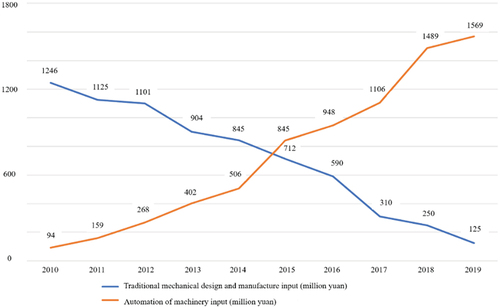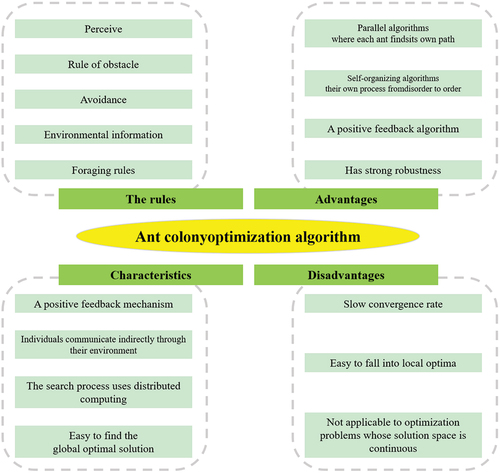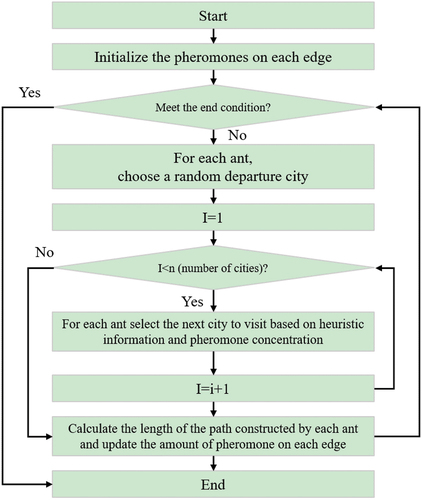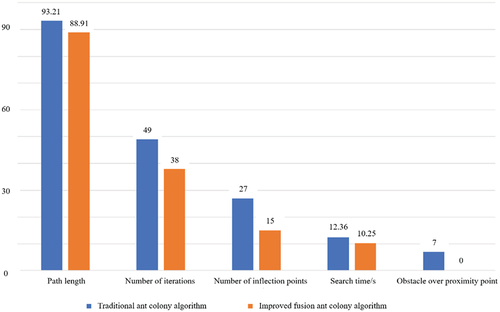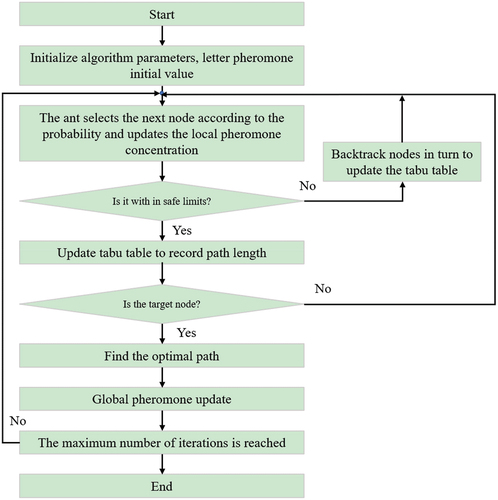 ?Mathematical formulae have been encoded as MathML and are displayed in this HTML version using MathJax in order to improve their display. Uncheck the box to turn MathJax off. This feature requires Javascript. Click on a formula to zoom.
?Mathematical formulae have been encoded as MathML and are displayed in this HTML version using MathJax in order to improve their display. Uncheck the box to turn MathJax off. This feature requires Javascript. Click on a formula to zoom.ABSTRACT
Mechanical automation plays a pivotal role in modern engineering and manufacturing, offering a wide array of benefits. By applying algorithms to automate mechanical systems, industries can capitalize on advantages such as error reduction, increased efficiency, and enhanced production quality. Among the various algorithms used in mechanical automation, the fusion ant colony algorithm stands out as a particularly effective approach that has demonstrated promising results. The fusion ant colony algorithm draws inspiration from the collective behavior of ants and focuses on identifying the shortest path between two points. This algorithm, when applied to mechanical systems, empowers engineers to optimize numerous processes and elevate the overall performance of the system. Furthermore, the fusion ant colony algorithm possesses the potential to enhance the intelligence of mechanical systems. By incorporating artificial intelligence and machine learning techniques, this algorithm enables machines to learn and adapt to dynamic environments, thereby improving their efficiency and productivity. In summary, the fusion ant colony algorithm stands as a powerful tool for automating mechanical systems. Through the utilization of collective behavior principles and optimization, this algorithm significantly enhances the performance and intelligence of machines. The outcomes include improved efficiency, productivity, and quality within the realms of mechanical engineering and manufacturing. By embracing the fusion ant colony algorithm, industries can unlock the full potential of mechanical automation and achieve remarkable progress in their operations.
Introduction and Research Background
With the rapid development of China’s economy, the machine manufacturing industry has become one of the most critical industries in the country. Traditional machinery manufacturing and automation have played a vital role in the growth of the industry. The evolution of human civilization has witnessed the development of simple tools into sophisticated machinery, which has been the cornerstone of mechanized design and manufacturing. The nineteenth century was a turning point in the mechanical industry, which led to significant technological advancements and had a profound impact on the development of China’s mechanical industry (Hamada et al. Citation2022). Machinery and automation remain the focal point of mechanical production, and it is the ultimate product of an organization and a combination of technological methods. As the machinery manufacturing industry occupies an increasingly important place in the national economy, the rapid increase in the level of science and technology has stimulated the reform and continuous development of the traditional machinery manufacturing industry. Technology, production methods, and management systems have been significantly improved (Chang et al. Citation2022).
Since ancient times, humans have used simple tools to help them survive. These tools have evolved over time and have led to the invention of sophisticated wind and water-powered devices. The introduction of machinery during the Industrial Revolution brought about significant changes in transportation and industry, leading to a new era of civilization (Schneider and Jasnin Citation2022; Yang, Zhang, and Liang Citation2015). With the advent of computers in the 21st century, traditional mechanical plants have been transformed into modern facilities, which have contributed significantly to human development and growth (Sharma, Kaur, and Kumar Mangal Citation2022). The use of robots, digitally controlled machine tools, and high-speed vehicles has become an integral part of modern-day human civilization. The integration of computers has played a crucial role in the promotion and dissemination of mechanization in China, which has contributed to both the development of productivity and the growth of the country (Jiang and Tang Citation2022). In this study, we aim to highlight the use of algorithms to improve traditional machinery-related content, which has the potential to significantly enhance the manufacturing industry’s productivity and efficiency. illustrates the comparison between traditional mechanical design and manufacturing and mechanical automation trends.
Figure 1. Comparison of traditional mechanical design and manufacturing and mechanical automation trends.
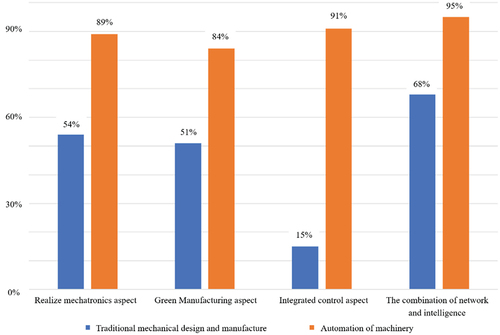
Mechanical manufacturing and automation, which includes mechanical engineering, automation, and mechanization engineering, is a promising technology. Its main characteristics are science, intelligence, and boundary. Science aims to apply technological achievements to mechanical engineering, increase standardization, and optimize design and manufacturing technologies. Intelligence involves the use of artificial intelligence to improve production efficiency. Boundary reflects the future direction of mechanical engineering and automation. China, which missed the opportunity to develop mechanical engineering during the industrial revolution, now invests heavily in the industry. However, due to the low level of industrial structure, integrated automation will be a long process. The future trends in machine manufacturing can be summarized in four points.
As the global economy improves, resource consumption, including nonrenewable raw materials, continues to increase. While resource exploitation has contributed to social development and progress, it has also caused environmental problems such as mining, leading to destruction of vegetation and soil pollution (Srivastava Citation2021). China has emphasized the importance of harmonious coexistence between human and nature and sustainable development. Machinery design, production, and automation should also consider environmental protection and energy efficiency to minimize waste and maximize efficiency (Nam et al. Citation2021; Zhong Citation2021).
To achieve diversified functions while minimizing equipment size, integrated control is necessary to save space, materials, and costs. It also facilitates operation and control (Liu et al. Citation2021). Network manufacturing, combined with intelligent technologies, reduces labor costs, improves product quality, and speeds up production (Zhu Citation2021).
compares the modernization level of traditional machinery design and manufacturing with machinery automation.
Figure 2. Comparison of the level of modernization between traditional mechanical design and manufacturing and mechanical automation.
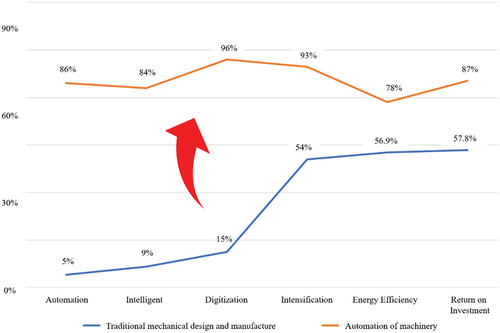
This paper utilizes artificial intelligence and machine learning techniques to empower machines to adapt and learn in dynamic environments, ultimately enhancing their productivity and efficiency. Specifically, the fusion ant colony algorithm brings novelty to the field of mechanical automation by integrating the principles of collective behavior and optimization. It combines the efficiency of ant colony algorithms with artificial intelligence and machine learning techniques, offering a unique approach to automating mechanical systems.
Summary of contributions of this research:
Reduction of human error: By automating mechanical systems using the fusion ant colony algorithm, the occurrence of human errors is significantly minimized. This leads to improved reliability and quality in engineering and manufacturing processes.
Increased efficiency: The fusion ant colony algorithm optimizes various processes within mechanical systems, resulting in enhanced efficiency. By identifying the shortest path between two points, it streamlines operations and reduces unnecessary delays, ultimately improving productivity.
Improved production quality: Through the fusion ant colony algorithm, mechanical systems can achieve better production quality. By optimizing processes, eliminating errors, and enhancing overall system performance, the algorithm contributes to higher standards of product output.
Intelligent adaptability: The fusion ant colony algorithm incorporates artificial intelligence and machine learning techniques, enabling mechanical systems to adapt to changing environments. This adaptability enhances the system’s efficiency and productivity, as machines can learn and optimize their operations based on real-time data.
Overall, the fusion ant colony algorithm’s contributions lie in its ability to automate mechanical systems effectively, reduce human error, increase efficiency, improve production quality, and enable intelligent adaptability. These contributions make it a valuable tool for enhancing mechanical engineering and manufacturing processes.
Research Progress of Mechanical Design, Manufacture and Automation
Research in the fields of mechanical design, manufacture, and automation has witnessed significant progress in recent years. Here are some notable areas of advancement:
Additive Manufacturing: Additive manufacturing, or 3D printing, has seen remarkable progress in terms of material options, print speeds, and the size and complexity of objects that can be produced. Researchers are exploring new materials, optimizing printing processes, and developing novel applications across various industries.
Digital Twin Technology: Digital twin technology has gained traction in mechanical design and manufacturing. It involves creating virtual replicas of physical systems, enabling real-time monitoring, analysis, and optimization. Researchers are exploring advanced simulation techniques, integration with Internet of Things (IoT) devices, and machine learning algorithms for enhanced digital twin capabilities.
Robotics and Automation: Advances in robotics and automation have revolutionized manufacturing processes. Collaborative robots (cobots) are becoming more prevalent, working alongside humans in production lines. Researchers are focusing on improving robot dexterity, machine learning for adaptive automation, and human-robot collaboration to increase productivity and safety.
Cyber-Physical Systems: The integration of physical systems with digital technologies has led to the development of cyber-physical systems (CPS). CPS combines sensors, actuators, and computing to enable real-time monitoring, control, and optimization. Research is centered around optimizing CPS architectures, developing intelligent control algorithms, and addressing cybersecurity challenges.
Machine Learning and AI: Machine learning and artificial intelligence (AI) have made significant contributions to mechanical design, manufacture, and automation. Researchers are applying these techniques for predictive maintenance, quality control, optimization, and decision-making processes. AI-driven systems are improving efficiency, reducing costs, and enhancing overall performance.
Sustainable Manufacturing: Sustainable manufacturing practices are gaining attention in research. Efforts are focused on developing eco-friendly materials, energy-efficient manufacturing processes, and life cycle assessments to minimize environmental impact. Researchers are also exploring circular economy principles, remanufacturing, and recycling techniques to achieve more sustainable manufacturing systems.
Human-Centered Design: The integration of human factors and ergonomics in mechanical design and automation has gained prominence. Researchers are studying user experience, human-robot interaction, and designing systems that prioritize safety, comfort, and usability. This approach aims to improve worker satisfaction, reduce injuries, and optimize system performance.
These are just a few examples of the research progress being made in mechanical design, manufacture, and automation. As technology continues to advance, researchers are constantly exploring innovative approaches to enhance efficiency, productivity, sustainability, and human-machine collaboration in these fields.
Comparison of Traditional and Automated Machine Design and Manufacturing
The principle of mechanical automation in design. Mechanical automation has always been designed for automatic sorting, editing, and problem solving. Therefore, machinery and electromechanical machinery must be combined in the design process to meet the needs of the manufacturing industry, the design is reasonable. In addition, automated systems are based on new technologies, such as cloud databases. These technologies allow automation to automatically connect data to the cloud, calibrate and optimize the data, and then calculate optimal ratios. According to the characteristics of mechanical automation and various functions and working principles, researchers must constantly develop ideas and lead product innovation. The difference between traditional mechanical design, production design and automation principles lie in the different functions of products. The most common difference is in the processing of product information. Traditional mechanical design cannot be a partitioned product of the system.
According to the development in recent years, mechanical automation products will replace the traditional mechanical products sooner or later. This is mainly because mechanical manufacturing automation greatly improves the functional level of mechanical products, brings additional benefits to production, not only improves the production efficiency, but also helps to improve the economic benefits of enterprises. The current society is in the process of modernization, rapid development is a social theme. The appearance of mechanical automation just meets the public’s demand for mechanical products. Accuracy and sensitivity can help manufacturing to achieve significant economic and social benefits and play a positive role. The advantage of traditional machine manufacturing is that automation can significantly improve the cost and efficiency of products in the production process. It can not only bring you economic and social benefits, but also allow you to take advantage of the traditional machinery manufacturing industry. But in the manufacturing process, traditional mechanical manufacturing is still people-oriented. Human subjective factors have a great influence on the final quality of products, which cannot effectively guarantee the conformity of products. ETSI BłDEM is the processing product of CNC machine tool. Mechanical disturbances, caused by human factors, prolong the production cycle, cause economic losses when necessary, and inevitably lead to lower work efficiency. Changing operators increases the company’s investment cost, wastes human and material resources, and improves the company’s financial interests.
The main objectives of traditional mechanical production projects are technical level, design principles, application and efficiency. Through the comparison of the traditional machinery manufacturing industry and mechanical automation, we can see that the traditional machinery manufacturing industry is difficult to survive and develop in the current social environment. Mechanical automation can adapt to modern conditions and provide a wide range of developments in harsh competitive environments. However, we cannot completely deny the traditional mechanical manufacturing and design which still has the advantage of mechanical automation. Therefore, we also need to understand the nature of scientific and technological innovation, remove impurities, and continue to delve into the field of mechanical automation.
Feature Analysis of Mechanical Automation Technology in Mechanical Design and Manufacturing
Systematic. Mechanical engineering automation system is a multidisciplinary, comprehensive system, involving software, communication, new materials, sensors and other high-tech, product manufacturing and manufacturing fields. In the analysis of mechanical engineering technology, it is necessary to understand its system characteristics, apply new technology in the background of mechanical design, and transform it into system engineering with process flow, energy flow and logistics.
The comprehensive development of machinery manufacturing automation can promote the improvement of enterprise competitiveness and the consolidation of national economy. Therefore, the production of enterprises should not be limited to the production link, but should focus on the pre-design, mid-end inspection and final sales links, such as industrial design, market research, product production and sales, service and other links. Mechanical engineering should be regarded as a comprehensive link that mobilizes all resources in an all-round way to improve its economic and social benefits. At the same time, the integration of mechanical design and production automation should be taken into account. shows the mechanical design and manufacturing and its automation capabilities.
Figure 3. Characteristics of mechanical design and manufacturing and its automation business capability.
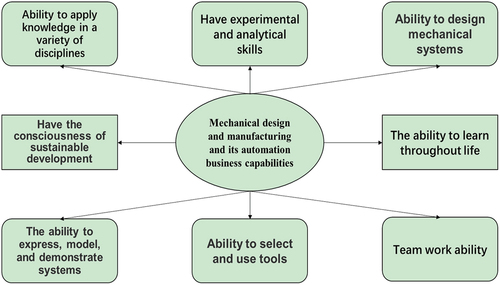
There is a market. Machinery manufacturing products must be market-oriented in order to achieve sales and generate economic and social benefits; mechanical products must accurately assess the market, meet the needs of market development, meet the production needs of different people and society, promote technological progress, computer science, quality control and cost control, improve production efficiency, and create better conditions for mechanical design and production automation.
According to the actual production situation. The application of automation technology in mechanical design and manufacturing should be integrated with production and physical needs, focusing on improving the efficiency of automation in practical applications. Currently, automation of machinery production is carried out using scientific and technical means, and economy is the main driver for reducing the cost and efficiency of machinery production. Automation of machinery design and production is itself a dynamic concept that must mobilize all levels of technology and create an adequate basis for automation, such as system design, integration technology and environmental management.
Use automation in development. As an important part of China’s economic development, the machinery manufacturing industry has been the backbone of Chinese industry. It has played an active role in China’s economic and social development. The automation and intelligence of machinery production reflects the innovation and development strength of China’s industry. Based on traditional machinery and equipment, machines are automatically converted and updated to replace the failures of traditional machines. Today, with the development of information technology, the automation of mechanical production design provides a solid foundation for the automation and intelligence of mechanical equipment. In addition, the effective use of automation leads to significant redundancy, leaving few employees and increasing the efficiency of production and management. Automation does not exclude people from the equation, but rather develops different parts of the automation unit and builds human-driven automation systems. Therefore, automation of machinery production must be people-oriented, strengthen the role of environmental protection, focus on energy saving and emission reduction, optimize the industrial structure, and continuously improve the productivity and quality of manufacturing without consuming too many natural resources.
The development trend of intelligence and virtualization is introduced. First of all, machinery automation is based on the combination of the traditional mechanical design model with science and information technology and mechanical engineering with strong logic processing potential. Driven by automation, mechanical engineering can achieve greater efficiency in industrial production and management by realizing human-machine interaction, production automation and mechanical equipment accuracy, precision and performance evaluation. At the same time, automation does not cause much pollution and can meet our current requirements for reducing energy efficiency. Secondly, virtualization has become one of the trends in the field of mechanical design and manufacturing automation, including the introduction of computer information technology and multimedia technology. Virtualization is an integrated multidisciplinary technology based on computer modeling and analysis techniques. It allows real-time monitoring of the machinery manufacturing process under information technology and virtualization conditions, simulating feedback problems in the production process, answering questions in a timely manner, and taking effective measures to create conditions for efficient and safe production.
The advancements in mechanical engineering and manufacturing have indeed resulted in improved efficiency, productivity, and quality. While quantification can vary depending on specific contexts and industries, here are some general areas where these improvements have been observed:
Enhanced Production Processes: Automation and optimization techniques have streamlined production processes, leading to increased efficiency and productivity. For example, the use of robotics and advanced control systems has reduced cycle times, minimized errors, and improved overall production output.
Higher Precision and Accuracy: Advances in precision machining, measurement technologies, and quality control systems have led to improved accuracy and reliability in mechanical engineering and manufacturing. This translates into higher quality products, reduced rework, and improved customer satisfaction.
Lean Manufacturing Practices: The adoption of lean manufacturing principles has contributed to improved efficiency and productivity. Techniques such as value stream mapping, waste reduction, and continuous improvement have helped optimize processes, eliminate non-value-added activities, and increase overall productivity.
Advanced Simulation and Modeling: The use of advanced simulation and modeling tools has significantly improved design and manufacturing processes. Virtual prototyping, finite element analysis, and computational fluid dynamics allow for more accurate predictions, optimization of designs, and reduction of development time and costs.
Supply Chain Optimization: Efforts in optimizing supply chain management have improved efficiency and productivity in manufacturing. Advanced planning and scheduling systems, real-time inventory tracking, and logistics optimization have minimized lead times, reduced inventory costs, and improved overall production planning and execution.
Continuous Improvement Culture: The focus on continuous improvement, supported by methodologies like Six Sigma and Total Quality Management, has led to ongoing enhancements in mechanical engineering and manufacturing. By encouraging a culture of problem-solving, data-driven decision-making, and employee involvement, organizations can drive efficiency, productivity, and quality improvements.
While it may be challenging to quantify these improvements precisely in all cases, the cumulative effect of these advancements is evident in the overall progress and success of the mechanical engineering and manufacturing industries. The continued adoption of innovative technologies, process optimization, and a commitment to quality improvement contributes to the ongoing enhancements in efficiency, productivity, and quality.
Improved Fusion Ant Colony Algorithm-Based Optimization
The fusion ant colony algorithm enhances the performance and intelligence of machines through several mechanisms:
Optimization: By applying the fusion ant colony algorithm to mechanical systems, engineers can optimize various processes. The algorithm helps identify the shortest path between two points, reducing unnecessary movements and delays. This optimization leads to improved efficiency and overall system performance.
Learning and Adaptation: The fusion ant colony algorithm incorporates artificial intelligence and machine learning techniques. Through continuous exposure to real-time data and feedback, machines can learn and adapt to changing environments. This learning capability enables machines to make informed decisions, adjust their operations, and optimize their performance accordingly.
Problem-solving: The fusion ant colony algorithm leverages the principles of collective behavior observed in ant colonies. Ants are known for their ability to find efficient solutions to complex problems, such as finding the shortest path between food sources and their nests. By applying these principles to mechanical systems, the algorithm aids in problem-solving and decision-making, enabling machines to tackle challenges more effectively.
Decision Optimization: The fusion ant colony algorithm assists in optimizing decision-making processes within mechanical systems. By evaluating multiple options and weighing their benefits, machines can make intelligent decisions that align with desired outcomes. This optimization of decision-making contributes to improved performance and efficiency.
Continuous Improvement: The fusion ant colony algorithm promotes a cycle of continuous improvement within mechanical systems. By analyzing performance data, identifying bottlenecks, and implementing adjustments, machines can continually enhance their operations over time. This iterative process results in increased intelligence and performance.
Overall, the fusion ant colony algorithm enhances machine performance and intelligence through optimization, learning, problem-solving, decision optimization, and continuous improvement. By leveraging these mechanisms, mechanical systems can achieve higher levels of efficiency, productivity, and adaptability, leading to improved overall performance.
Ways to Improve Mechanical Design and Manufacturing and Automation
Application supporting development mode. In the process of promoting machinery manufacturing innovation and automation, we must make full use of the comprehensive development mode. In the development of machinery manufacturing industry, we should grasp the positive role of people and logistics in production and make a good overall plan for various links. Form a correct representation, rational analysis of the specific role of people and logistics, make full use of the various application significance of communication. In the process of developing engineering companies, in addition to paying attention to infrastructure construction, it is also necessary to make full use of and strengthen cross-departmental integration, learn from the enterprise way and embedded development mode, encourage the effective development of parts detection technology and computer technology, and improve the influence and comprehensive competitiveness of enterprises in the process of social development.
Improve the ecological benefits of machinery manufacturing technology. Now people are becoming more and more aware of the need to protect the environment. The development of all industries should adhere to the principle of green development, improve the ecological benefits of machinery manufacturing industry, and ensure economic and social benefits. In the process of practice and exploration, we should adhere to the concept of environmental protection and energy conservation, so that the mechanical industry and environmental protection in the development of coordination. At present, global environmental problems are becoming more and more serious, causing a serious impact on human life. Therefore, we must pay more attention to environmental protection. In the development of China’s machinery industry, we must adhere to the concept of ecology to stimulate the innovation and development of machinery enterprises. First of all, environmental protection should be fully considered when improving the level of mechanical automation.
Machine Automation Improved with Algorithms
In recent years, there has been a significant increase in China’s investment in mechanical automation research, surpassing that of traditional mechanical design and manufacturing, as shown in . This shift toward automation aligns with the trend of intellectualization, providing a complete production process that is built automatically by electronic equipment, ensuring standardization. Combining computer-aided programming with mechanical engineering can significantly enhance production efficiency. Additionally, computer technology development and application promote the automation of mechanical manufacturing and design, enabling effective connectivity of production processes through networks. The integration of internet technology can help resolve downtime issues caused by a lack of technicians or work breakdowns in traditional machine manufacturing. Moreover, virtual design can present virtual samples using web technology and related data, allowing technicians to visualize the entire production process and enabling designers to modify the web instead of redrawing designs, thus saving resources. To conclude, the adoption of automation, network development, and virtualization has the potential to transform traditional mechanical design and manufacturing, leading to increased production efficiency, reduced downtime, and improved resource utilization.
Theory of Ant Colony Optimization Algorithm
The ant colony optimization (ACO) algorithm was first introduced in 1996 by European computer scientists as a heuristic algorithm that utilized positive feedback and distributed computing power. The algorithm, inspired by the foraging behavior of ants, was initially designed to find the shortest path from the food source to the nest and gained attention for its ability to solve the traveling salesman problem (TSP). Subsequently, the ant system was proposed, which aimed to better solve the optimization problem of finding the optimal path and improve the overall efficiency of the algorithm. The original researchers aimed to maximize path selection optimization within a certain range and limited it to a local area to avoid excessive information accumulation and local optimization, thus increasing the diversity of the algorithm. Although the ACO algorithm has global search capabilities, robustness, and parallel directionality, it still faces challenges such as slow convergence and small degree of stagnation as the scope of the solution is expanded. To address these challenges, various modifications and improvements have been made to the algorithm, such as the introduction of pheromone evaporation rate control and the use of multi-objective optimization techniques. provides a visual representation of the ant colony optimization algorithm and its components, including the pheromone trail, ant agents, and the search space. Despite its limitations, the ACO algorithm remains a widely studied and applied metaheuristic algorithm, with applications in various fields such as transportation, telecommunications, and manufacturing.
To address these challenges, researchers have conducted various studies, both domestically and internationally. Domestic scholars have used other algorithms such as neural networks and particle swarm optimization to optimize the path before utilizing the ant colony optimization algorithm. However, issues were found during the optimization process, leading to the proposal of using the ant swarm algorithm for context selection to better optimize the path through the connection between local and overall analysis. Despite its advantages, the ant colony optimization algorithm had weaknesses and fragility that limited its effectiveness. To mitigate these issues, scientists explored other methods, such as bacterial selection and reproduction, to eliminate these limitations and improve efficiency. The algorithm’s accuracy and convergence to ambiguity were also studied, leading to the development of an adaptive measurement algorithm of population diversity and an update strategy of transmission rules and information elements to avoid local optimization and accelerate convergence. illustrates the basic ant colony optimization algorithm.
Improvement of Fusion Ant Colony Algorithm
In the process of searching and exploring the nodes, traditional swarm algorithms rely on the principle that if the current close position is not the best, then the overall algorithm calculation may not find the best position. This study conducted a comparison between the improved fusion ant colony algorithm and the traditional ant colony algorithm, and the results are depicted in . The comparative analysis reveals that the improved fusion ant colony algorithm surpasses the traditional one in terms of performance and efficiency, thereby indicating its potential for a wide range of applications. Specifically, the improved algorithm exhibits faster convergence and higher accuracy in solving optimization problems, which is a significant advantage over traditional algorithms. Furthermore, the improved algorithm demonstrates robustness and reliability, making it suitable for solving complex real-world problems. These findings suggest that the improved fusion ant colony algorithm is a promising research direction for future swarm algorithm development.
The specific information inspired by the improved fusion swarm algorithm in this paper is shown below.
is the specific expectation seeking process.
EquationEquation 4(4)
(4) is a single process like addition, but the specific use of this paper is infinite summation, just for a single summation to find the limit, is a simple mathematical problem, this paper does not emphasize too much.
The equation presented here calculates the total integral estimate and a result indicating good normal performance means that the data is well-behaved. This paper focuses on optimizing the improved fusion ant colony algorithm by exploring various aspects of mechanical manufacturing, design, automation, and more. By doing so, a better optimization path is discovered and the ant colony algorithm used in this research is significantly improved. The specific flow of the algorithm is depicted in .
Conclusion
In conclusion, the machinery manufacturing industry plays a crucial role in the national economy, and its continuous development is driven by the rapid advancement of science and technology. This paper has presented a comparative analysis of traditional mechanical design and manufacturing and mechanical automation using an improved fusion ant colony algorithm. The study highlights the importance of using algorithms to improve traditional machinery-related content. As humans have evolved and progressed, from using simple tools to more sophisticated wind and water powered devices, the introduction of steam engines and motors during the National Industrial Revolution marked a significant turning point in the history of civilization.
Today, mechanical engineering and automation are among the most promising and cutting-edge technologies. This research offers relevant ways to enhance the development of machinery manufacturing technology in China, such as applying a supporting development mode, enhancing eco-efficiency, and focusing on the development trend of mechanical design and manufacturing and its automation. With these efforts, it is believe that China’s machinery manufacturing industry will continue to thrive and contribute significantly to the country’s economic development.
It is important to note that while the fusion ant colony algorithm brings significant contributions to mechanical automation, a comparison with more recent techniques will be the subject of future research. As technology and methodologies continue to evolve rapidly, it is essential to explore and evaluate the advancements made in the field. Therefore, future studies can focus on comparing the fusion ant colony algorithm with newer techniques to assess their respective strengths, limitations, and applicability to different scenarios within mechanical automation. By conducting such research, a deeper understanding of the algorithm’s position in relation to more recent developments can be obtained, enabling further advancements and improvements in the field.
Disclosure statement
No potential conflict of interest was reported by the author(s).
Additional information
Funding
References
- Chang, L., Y. Huang, N. Ullah, L. Zhu, L. Zhenyu, and Y. Jing. 2022. Torsional stiffness analysis based on Lagrangian method for precision rotary vector reducer with involute variable tooth thickness. Applied Sciences 12 (14):7003. doi:10.3390/app12147003.
- Hamada, K., K. Kunihiro, A. Setyo Anggito Utomo, M. Ahli, R. Lesmana, Y. Kobayashi, T. Yoshimoto, T. Shimizu, T. Yoshimoto, and T. Shimizu. 2022. Automated pipe routing optimization for ship machinery. Journal of Marine Science and Application 21 (2):170–1902. doi:10.1007/s11804-022-00269-8.
- Jiang, H., and Y. Tang. 2022. Development of mechanical design, manufacturing and automation. Journal of Physics: Conference Series, Nanjing, China.
- Liu, R., Z. Hou, Q. Liu, and X. Ding. 2021. “The control system of mountainous multi-function miniature pile drill WZFT.” Journal of Physics: Conference Series, Hangzhou, China.
- Nam, K.-C., Y.-J. Kim, H.-J. Kim, C.-W. Jeon, and W.-S. Kim. 2021. A study on autonomy level classification for self-propelled agricultural machines. Korean Journal of Agricultural Science 48 (3):617–27.
- Schneider, J., and M. Jasnin. 2022. Capturing actin assemblies in cells using in situ cryo-electron tomography. European Journal of Cell Biology 101 (3):151224. doi:10.1016/j.ejcb.2022.151224.
- Sharma, G., T. Kaur, and S. Kumar Mangal. 2022. Fault diagnosis and prediction with industrial internet of things on bearing and gear assembly. International Journal of Sensor Networks 39 (4):246–55. doi:10.1504/IJSNET.2022.125114.
- Srivastava, S. K. 2021. Agricultural automation: A strategic dilemma of a rich Indian farmer. Journal of Information Technology Teaching Cases 11 (2):117–21. doi:10.1177/2043886920951200.
- Yang, H., L. Zhang, and J. Liang. 2015. Research on cultivation mode of application-oriented innovative talents specialized in engineering. 2016 International Conference on Contemporary Education, St. Petersburg, Russia, Social Sciences and Humanities.
- Zhong, P. 2021. Application and development of neural network technology in mechanical automatic processing parameters. Journal of Physics: Conference Series, Beijing, China.
- Zhu, P. 2021. Safety control of mechanical design automation equipment with computer aid. Journal of Physics: Conference Series, Yunnan, China.

